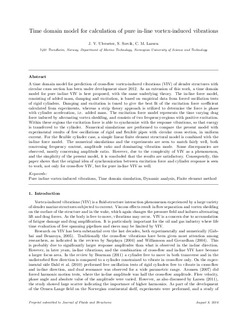| dc.contributor.author | Ulveseter, Jan Vidar | |
| dc.contributor.author | Sævik, Svein | |
| dc.contributor.author | Larsen, Carl Martin | |
| dc.date.accessioned | 2017-05-11T08:33:51Z | |
| dc.date.available | 2017-05-11T08:33:51Z | |
| dc.date.created | 2016-12-15T14:39:36Z | |
| dc.date.issued | 2017 | |
| dc.identifier.citation | Journal of Fluids and Structures. 2017, 68 158-173. | nb_NO |
| dc.identifier.issn | 0889-9746 | |
| dc.identifier.uri | http://hdl.handle.net/11250/2442234 | |
| dc.description.abstract | A time domain model for prediction of cross-flow vortex-induced vibrations (VIV) of slender structures with circular cross section has been under development since 2012. As an extension of this work, a time domain model for pure in-line VIV is here proposed, with the same underlying theory. The in-line force model, consisting of added mass, damping and excitation, is based on empirical data from forced oscillation tests of rigid cylinders. Damping and excitation is tuned to give the best fit of the excitation force coefficient calculated from experiments, whereas a strip theory approach is utilized to determine the force is phase with cylinder acceleration, i.e. added mass. The excitation force model represents the time varying drag force induced by vortex shedding, and consists of two frequency-regions with positive excitation. Within these regions the excitation force is able to synchronize with the response vibrations, so that energy is transferred to the cylinder. Numerical simulations are performed to compare the present model with experimental results of free oscillations of rigid and flexible pipes with circular cross section, in uniform current. For the flexible cylinder case, a simple linear finite element structural model is combined with the in-line force model. The numerical simulations and the experiments are seen to match fairly well, both concerning frequency content, amplitude ratio and dominating vibration mode. Some discrepancies are observed, mostly concerning amplitude ratio. However, due to the complexity of VIV as a phenomenon, and the simplicity of the present model, it is concluded that the results are satisfactory. Consequently, this paper shows that the original idea of synchronization between excitation force and cylinder response is seen to work, not only for cross-flow VIV, but for pure in-line VIV as well. | nb_NO |
| dc.language.iso | eng | nb_NO |
| dc.publisher | Elsevier | nb_NO |
| dc.rights | Attribution-NonCommercial-NoDerivatives 4.0 Internasjonal | * |
| dc.rights.uri | http://creativecommons.org/licenses/by-nc-nd/4.0/deed.no | * |
| dc.title | Time domain model for calculation of pure in-line vortex-induced vibrations | nb_NO |
| dc.type | Journal article | nb_NO |
| dc.type | Peer reviewed | nb_NO |
| dc.description.version | acceptedVersion | nb_NO |
| dc.source.pagenumber | 158-173 | nb_NO |
| dc.source.volume | 68 | nb_NO |
| dc.source.journal | Journal of Fluids and Structures | nb_NO |
| dc.identifier.doi | 10.1016/j.jfluidstructs.2016.10.013 | |
| dc.identifier.cristin | 1413546 | |
| dc.relation.project | Norges forskningsråd: 237929 | nb_NO |
| dc.description.localcode | © 2016 Elsevier Ltd. All rights reserved. This is the authors' accepted and refereed manuscript to the article. Locked until January 31 2019 due to copyright restrictions | nb_NO |
| cristin.unitcode | 194,64,20,0 | |
| cristin.unitname | Institutt for marin teknikk | |
| cristin.ispublished | true | |
| cristin.fulltext | postprint | |
| cristin.qualitycode | 1 | |

